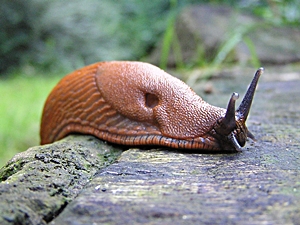
Durham slug (Arion vulgaris). Picture: Robert Nordsieck.
Of all known gastropod groups, and the slugs in particular, the round back slugs (Arionidae) probably suffer from the worst reputation. That is of course caused by the apparently large number of species among them, regarded as a threat or at least harmful to human agriculture and gardens. On the other hand, the round back slugs are a very interesting group with many very different species, from very small to very large size (about 25 cm).
 Durham slug (Arion vulgaris). Picture: Robert Nordsieck. |
Class:
Gastropoda
![]() Subclass:
Pulmonata
Subclass:
Pulmonata
![]() Superorder:
Eupulmonata
Superorder:
Eupulmonata
![]() Order:
Stylommatophora
Order:
Stylommatophora
![]() Suborder:
Sigmurethra
Suborder:
Sigmurethra
![]() Infraorder:
Arionoinei
Infraorder:
Arionoinei
![]() Superfamily:
Arionoidea
Superfamily:
Arionoidea
![]() Family:
Arionidae Gray 1840
Family:
Arionidae Gray 1840
![]() Source: Mollbase on
http://www.mollbase.de/list/.
Source: Mollbase on
http://www.mollbase.de/list/.
From outside, the round back slugs are distinctly different, for example from the keel back slugs (Limacidae), by their rather corpulent stature and the generally more or less absent dorsal keel. Hence their colloquial name round back slugs, as opposed to keel back slugs.
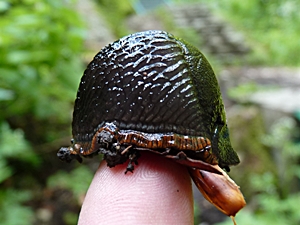 Protective position of the Giant red slug (Arion rufus). Picture: Martina Eleveld. |
|
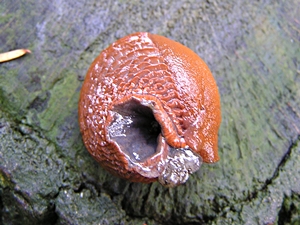 Round back slugs, contrary to keel back slugs can roll themsel- ves in for protection. [RN] |
Contrary to the keel back slugs (Limacidae and Milacidae), as well as their smaller relatives, the field slugs (Agriolimacidae), the respiratory opening in round back slugs is located in the middle or the anterior (frontal) half of the mantle shield. What keel back slugs cannot do, but round back slugs characteristically can, is to roll their body to a ball to protect it. To do so, the slug first contracts the body to form a hunchback and then pulls together the foot sole, so it forms a ball. That way, the slug is less easily attacked and a predator will only be able to swallow it with difficulty.
At their posterior (tail) end, round back slugs have a mucus gland at the dorsal side. So they often carry around a mucus blob at their tail end. At least some slugs' body mucus can be quite characteristic, such as the dusky slug's (Arion subfuscus) orange or at least yellowish slime.
Contrary to other slug groups, the European round back slugs do not have any shell left. The only remains of the shell those slugs once had in their evolutionary history, are calcareous grains under the mantle shield. But round back slugs, or scientifically Arionids, are not confined to Central Europe. The American jumping slugs of the Hemphillia genus, for example, still have a shell, only they carry it under the mantle shield, which gives them a weird, hunch-backed appearance. There are also other groups which have shells, reduced to a larger or lesser extent, which makes them similar to the European glass snails (Vitrinidae).
Genera in the Arionidae family
Anadenulus
Ariolimax
Arion (the only genus present in Europe)
Binneya
Geomalacus
Gliabates
Hemphillia
Hesperarion
Magnipelta
Prophysaon
Udosarx
Zacoleus
Source: Encyclopedia of Life (EOL) (without Geomalacus).
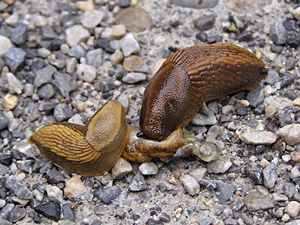 Two juveniles of the Lusitanian slug (Arion vulgaris) feeding on a smaller conspecific. [RN] |
Very often, closely related round back slug species can only be distinguished by their genital apparatus, because their exterior is so variable. Only some species possess a penis, but almost all have an epiphallus (which normally is the penis posterior extension), which is where the spermatophore is built. Instead, the genital atrium is well developed an is also used for copulation purposes. Besides, in the genus Arion, a stimulatory organ, called a ligula, can be present.
Round back slugs' nutrition is extremely various. Especially the Lusitanian slug (Arion vulgaris), probably the most common indigenous species (actually it is not indigenous, but a species introduced from the Iberian peninsula, a so called neozoon), rather conspicuously not only feeds on green food (for which it is notorious), but also a large portion of meat diet, such as earthworms, snail eggs, but also other snails and even other slugs (see also: Slugs and the variety of food sources).
Arionidae are distributed throughout the faunal provinces of the Nearctic (North America), Palaearctic (Europe and the northern part of Asia), as well, as the Oriental. Many round back slug species common to Europe have been distributed by man far outside of their original area of occurrence, so today they are also found in North America and Australia.
In Europe, there are no subfamilies in the Arionidae family, and the European round back slugs belong to one of two genera: Arion and Geomalacus. The genus Arion, on the other hand, has been divided into several subgenera: Arion (among them the three large European species Arion ater, Arion rufus and Arion vulgaris), Mesarion (e.g. Arion (M.) subfuscus), Carinarion (e.g. Arion (C.) silvaticus) and Kobeltia (z.B. Arion (K.) hortensis), named after the malacologist Wilhelm Kobelt (1840 - 1916).
 Hermann Löns (1866 - 1914) also wrote about slugs. |
The round back slugs with their bad reputation have received literary attention by the German writer Hermann Löns, who usually is known better for writing stories about hunting and especially about the Lüneburg moors in Northern Germany. But Hermann Löns was also a quite established malacologist, who wrote scientific descriptions about many gastropod species. He also established the malacological collection in the Münster museum. In 1911, he published the humorous short story "Ein ekliges Tier - a disgusting creature" about slugs. Three years later, he was killed attacking a French village in World War I.
Part 1: Larger species
Giant red slug (Arion rufus)
Giant black slug (Arion ater)
Lusitanian slug (Arion vulgaris) (Durham slug)
Part 2: Smaller species
Dusky arion (Arion subfuscus)
Forest arion or silver slug (Arion silvaticus)
Orange-banded arion (Arion fasciatus)
Brown-banded arion (Arion circumscriptus)
Hedgehog arion (Arion intermedius)
Dark face arion (Arion distinctus)
Garden slug (Arion hortensis) (Black field slug)
Especially in older literature, there is also the scientific name Arion empiricorum A. FÚrussac 1819 (among others in the above mentioned short story by Hermann Löns). Also often found (e.g. Kerney et al., 1979) is the description of both as subspecies of one species, Arion ater rufus and Arion ater ater. For one, today it is known that the names by LinnÚ are older and therefore more valuable, but also, both are quite well established as different species on the grounds of their morphology, especially genital, their biology and their mating behaviour (see v. Proschwitz 1985, Source: Mollbase).
Only seen from the outside, the giant red slug, the giant black slug and the Lusitanian slug are only very hard to tell apart. All three species have red, black (with the exception of the Lusitanian slug) and brown specimens. The red slug and the black slugs can even be white. Without an anatomical examination at the cost of the slug's life, the species cannot usually be determined with certainty. The best way usually is to have a look at the juveniles, which are quite conspicuous in all three species.
Giant red slug or Chocolate arion - Arion rufus (Linnaeus
1758)
![]()
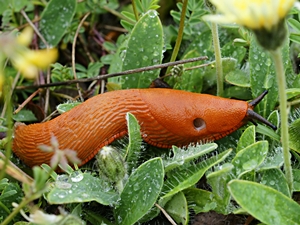 Giant red slug or Chocolate slug (Arion rufus) from Belgium. Picture: Hans Hillewaert. |
Description: Like its name states, the giant red slug usually is red. There are also brown and black specimens, but those have a red foot seam (f in the picture above). The foot sole, in contrary is light grey, cream coloured or reddish. The tentacles are blackish brown and can be palely striped. The juveniles, contrary to the adults, are of a pale yellowish colour or light orange with a dark head.
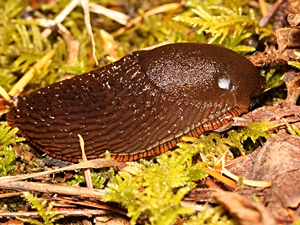 A dark red specimen of the giant red slug (Arion rufus) from Washington State, USA. Picture: Walter Siegmund. |
|
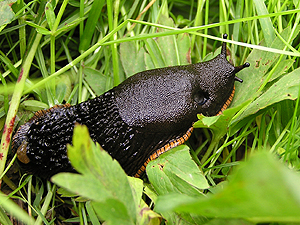 A black specimen of the giant red slug from Hesse in Germany. Well visible: The red foot seam in both specimens. [RN] |
![]() Jacksonville Shell Club:
Arion rufus -
Chocolate Arion juvenile.
Jacksonville Shell Club:
Arion rufus -
Chocolate Arion juvenile.
During copulation the very large genital atrium is visible. In an anatomical examination of the genital apparatus the epiphallus can be recognized as being no much wider than the spermioduct (Vas deferens). The seminal pouch (Spermatheca) is spherical.
There are several forms of this species, the status of which has yet to be determined. Probably the continental form is sufficiently different from that of the British Isles to make an independent species (von Proschwitz on Mollbase).
Dimensions: L: Up to 150 mm, exceptionally up to 180 mm.
Habitat and Distribution: The giant red slugs lives in natural humid forests and on humid meadows, near water bodies and in swamps. Since the 1970s, however, in many places it has been replaced by the Lusitanian slug (Arion vulgaris). Arion rufus feeds on green and decaying plant matter, mushrooms, animal droppings and carrion. The giant red slug is an annual species - mating takes place in summer, auto-fertilization is also an option. In autumn, about 500 eggs can be laid, the juveniles hatching after a month. They hibernate, whereas the adults die.
Threat situation: Originally the Giant red slug was wide spread in Central and Western Europe, also living as a commensal species in human gardens. Since it is replaced by the Lusitanian slug, it has become increasingly rare and has all but disappeared from anthropogenous habitats. While the species is declining in Bavaria, it is already classified as vulnerable in Austria.
![]() Mollbase:
Arion rufus.
Mollbase:
Arion rufus.
![]() Francisco
Welter-Schultes:
Arion rufus species homepage.
Francisco
Welter-Schultes:
Arion rufus species homepage.
Giant black slug - Arion ater (Linnaeus
1758)
![]()
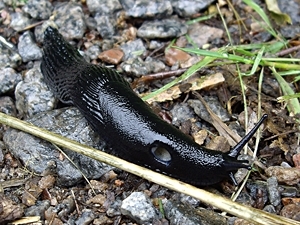 Giant black slug (Arion ater) from the island of Bornholm (Denmark). Picture: Francisco Welter-Schultes (Animal Base). |
Description: True to its name, the giant black slug usually is jet black. Other than in the red slug, the foot seam is also black. Especially conspicuous are the juveniles - those are ivory coloured with a black head (see also: Black Arion Juvenile on jaxshells.org). But they become grey quite fast with advancing age, adolescent slugs quite often are already black. In contrary, the young of Lusitanian slugs are quite characteristically banded.
Especially in the northern parts of Europe, the black slug sometimes maintains its juvenile pale colour even in the adult stage. So adult specimens might be encountered with cream or ivory coloured bodies and foot seams. The appearance of such a slug with a pale body and a dark head allows the assumption (!) that here the juvenile colour might have been kept in adulthood.
The genital apparatus' morphology is different from related species: Atrium and vagina are noticeably narrower than the spherical spermatheca. The oviduct also is narrow.
Dimensions: L: Up to 130 mm.
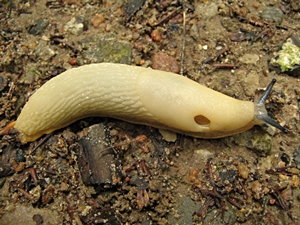 A white specimen of Arion ater from Schleswig Holstein. Picture: ę Jule Schiffbauer. |
Habitat and Distribution: The black slug prefers humid habitats, mostly closer in more rugged landscapes than Arion rufus, and it mainly occurs in forests. In Spain the black slug also lives as a commensal species and may become a garden pest in some places. Black slugs live on green and decaying plant matter, so their diet is similar to that of the red slug. Black slugs lay about 150 eggs per batch, which they place under moss, only rarely also in the earth. Later in the year, the egg count may decline to about 20 eggs per batch. After almost a month, the juveniles hatch, and like in the red slug, it is them who hibernate, while the adults die.
In contrary to the giant red slug, the black slug is distributed more to the North of Europe: Its distribution area covers North and Northwest Europe, in Scandinavia beyond the 61st degree of latitude, it remain confined to the coast.
Threat situation: In Britain, the giant black slug seems to be one of the most frequent and widespread mollusc species, but it has to be taken into account that until 1999, Kerney described Arion ater and Arion rufus as one species (see above). In Lower Saxony, the species is vulnerable.
![]() Mollbase:
Arion ater.
Mollbase:
Arion ater.
![]() Francisco
Welter-Schultes:
Arion ater species homepage.
Francisco
Welter-Schultes:
Arion ater species homepage.
Lusitanian slug - Arion vulgaris Moquin-Tandon
1855
![]()
After the so-called Lusitanian slug had been falsely determined in 1956 by van Regteren as Arion lusitanicus Mabille 1868, in the time since scientist have found out that the original species Arion lusitanicus actually is an endemic species, occurring only in a limited area in Portugal. It is noticeably different from the species known for a speedy distribution (referred to today as Arion vulgaris), if not by external appearance, so by a different number of chromosomes (lusitanicus: 24; vulgaris, rufus und ater: 26; according to ěrmen et al. 2009, the latter three might form a species complex).
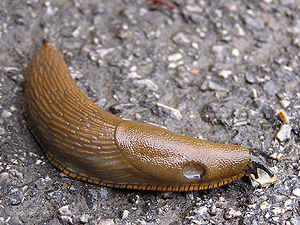 Lusitanian slug (Arion vulgaris) from Vienna. [RN] |
|
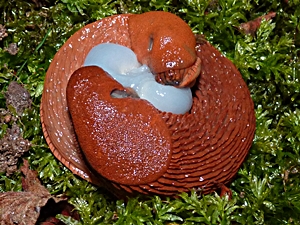 Durham slugs mating (Arion vulgaris). Picture: Martina Eleveld. |
Description: The Lusitanian slug is quite variable in its colour: Between brownish and reddish brown until brick red and orange. As variable as the species is as such, the colouring of single populations usually remains constant. While the adult specimens are only little different from a giant red slug in external appearance, the juveniles are quite conspicuously coloured (see above), which allows for a clear determination of the species.
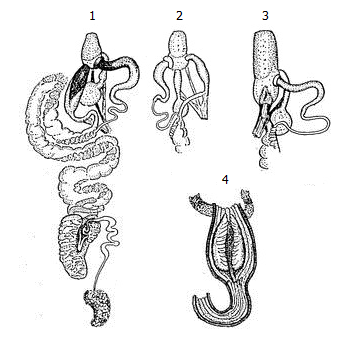 Genital apparatus of Arion vulgaris (1), A. subfuscus (2) and A. ater (3). 2 and 3: Distal part. 4: Ligula of Arion vulgaris, dissected. 1: Epiphallus on the right side, 2 and 3: Epiphallus on the left side. Source: Quick, H. E. (J. Moll. Stud. 1951), there: Arion lusitanicus. |
The genital apparatus of Arion vulgaris is quite characteristically built: The genital atrium is small, but the oviduct is very large and swollen, with about the same diameter as the atrium. The spherical spermatheca has about double the oviduct's diameter. The long oviduct and a long lancet-shaped ligula as a stimulation organ in the atrium are typical characters for Arion vulgaris.
Dimensions: L: 80 - 120 mm.
Habitat and Distribution: The Lusitanian slug is well known for inhabiting very different and various habitats. As a commensal species it can be found in all kinds of anthropogenous habitats, but also in natural habitats, such as near water bodies, forest rims, valley forests and semi-dry meadows. In Switzerland, the Lusitanian slug lives in altitudes of up to 1700 m MSL.
In a large part of its distribution area, the Lusitanian slug is a severe agricultural pest, because it is quite fertile (up to 400 eggs per batch) and sometimes also survives the winter, though the species as such is annual like the other large Arion species. Besides, the Lusitanian slug replaces the other large round back snails by food competition, feeding on their egg batches, but even on the slugs themselves, but probably also by trans-specific mating (bastardization).
It is assumed that the so-called Lusitanian (i.e. Portuguese) slug originally came either from the Southwest of France or the West of the Iberian peninsula and of France.
The Lusitanian slug has become one of the most frequent mollusc species in its fast spreading distribution area in Europe. The distribution of the species presumably takes place largely by transports of earth with the eggs within, as well as unwashed vegetables with slugs. In Switzerland, the species is known since 1956, in Britain since 1954. There is is also called the Durham slug, from where it was first found. In Germany the species was first discovered in 1969 (Schmid, 1970), in Austria in 1972 (Reischütz, 1972). But the Lusitanian slug is also spreading in Britain and, as "master of efficient distribution" ("Tehokkaan levińmisen mestari", Valovirta, I.) also in Scandinavia.
Research from Norway has resulted in that the Lusitanian slug's distribution might be limited by leopard slug (Limax maximus) predation (ěrmen et al., 2009, 2011).
Literature
|
|
ěrmen, T.; Winter, B.; B°ckman, P. (2010): Negativ tetthetsavhengighet mellom de skall°se snegleslektene Limax og Arion. Fauna 62(3) 2010 94–99. (Negative correlation between the population densities of the slug genera Limax and Arion). (The paper can be accessed here). |
![]() Mollbase:
Arion vulgaris.
Mollbase:
Arion vulgaris.
![]() Francisco
Welter-Schultes:
Arion vulgaris species homepage.
Francisco
Welter-Schultes:
Arion vulgaris species homepage.
![]() Moquin-Tandon,
A. (1855): Histoire naturelle des mollusques
terrestres et fluviatiles de France.
Read Online,
PDF (33 MB).
Moquin-Tandon,
A. (1855): Histoire naturelle des mollusques
terrestres et fluviatiles de France.
Read Online,
PDF (33 MB).
![]() Slugs - A Guide to the Invasive and Native Fauna of California (University
of California, 2009) (PDF, 1,5 MB).
Slugs - A Guide to the Invasive and Native Fauna of California (University
of California, 2009) (PDF, 1,5 MB).
![]() BBC:
Guide to Nottinghamshire Slugs.
BBC:
Guide to Nottinghamshire Slugs.